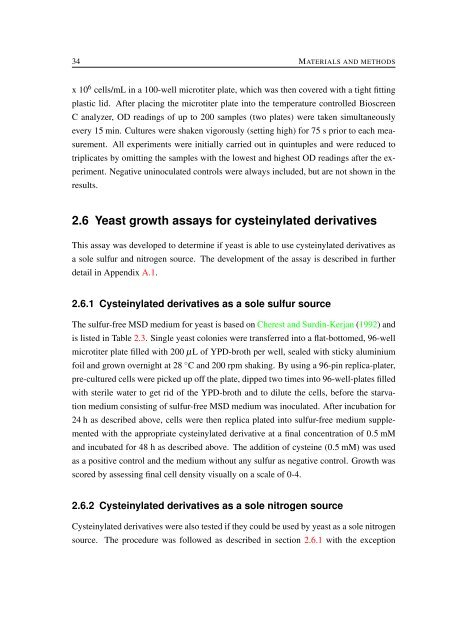Identification of yeast genes involved in Sauvignon Blanc aroma ...
Identification of yeast genes involved in Sauvignon Blanc aroma ...
Identification of yeast genes involved in Sauvignon Blanc aroma ...
You also want an ePaper? Increase the reach of your titles
YUMPU automatically turns print PDFs into web optimized ePapers that Google loves.
34 MATERIALS AND METHODSx 10 6 cells/mL <strong>in</strong> a 100-well microtiter plate, which was then covered with a tight fitt<strong>in</strong>gplastic lid. After plac<strong>in</strong>g the microtiter plate <strong>in</strong>to the temperature controlled BioscreenC analyzer, OD read<strong>in</strong>gs <strong>of</strong> up to 200 samples (two plates) were taken simultaneouslyevery 15 m<strong>in</strong>. Cultures were shaken vigorously (sett<strong>in</strong>g high) for 75 s prior to each measurement.All experiments were <strong>in</strong>itially carried out <strong>in</strong> qu<strong>in</strong>tuples and were reduced totriplicates by omitt<strong>in</strong>g the samples with the lowest and highest OD read<strong>in</strong>gs after the experiment.Negative un<strong>in</strong>oculated controls were always <strong>in</strong>cluded, but are not shown <strong>in</strong> theresults.2.6 Yeast growth assays for cyste<strong>in</strong>ylated derivativesThis assay was developed to determ<strong>in</strong>e if <strong>yeast</strong> is able to use cyste<strong>in</strong>ylated derivatives asa sole sulfur and nitrogen source. The development <strong>of</strong> the assay is described <strong>in</strong> furtherdetail <strong>in</strong> Appendix A.1.2.6.1 Cyste<strong>in</strong>ylated derivatives as a sole sulfur sourceThe sulfur-free MSD medium for <strong>yeast</strong> is based on Cherest and Surd<strong>in</strong>-Kerjan (1992) andis listed <strong>in</strong> Table 2.3. S<strong>in</strong>gle <strong>yeast</strong> colonies were transferred <strong>in</strong>to a flat-bottomed, 96-wellmicrotiter plate filled with 200 µL <strong>of</strong> YPD-broth per well, sealed with sticky alum<strong>in</strong>iumfoil and grown overnight at 28 ◦ C and 200 rpm shak<strong>in</strong>g. By us<strong>in</strong>g a 96-p<strong>in</strong> replica-plater,pre-cultured cells were picked up <strong>of</strong>f the plate, dipped two times <strong>in</strong>to 96-well-plates filledwith sterile water to get rid <strong>of</strong> the YPD-broth and to dilute the cells, before the starvationmedium consist<strong>in</strong>g <strong>of</strong> sulfur-free MSD medium was <strong>in</strong>oculated. After <strong>in</strong>cubation for24 h as described above, cells were then replica plated <strong>in</strong>to sulfur-free medium supplementedwith the appropriate cyste<strong>in</strong>ylated derivative at a f<strong>in</strong>al concentration <strong>of</strong> 0.5 mMand <strong>in</strong>cubated for 48 h as described above. The addition <strong>of</strong> cyste<strong>in</strong>e (0.5 mM) was usedas a positive control and the medium without any sulfur as negative control. Growth wasscored by assess<strong>in</strong>g f<strong>in</strong>al cell density visually on a scale <strong>of</strong> 0-4.2.6.2 Cyste<strong>in</strong>ylated derivatives as a sole nitrogen sourceCyste<strong>in</strong>ylated derivatives were also tested if they could be used by <strong>yeast</strong> as a sole nitrogensource. The procedure was followed as described <strong>in</strong> section 2.6.1 with the exception














